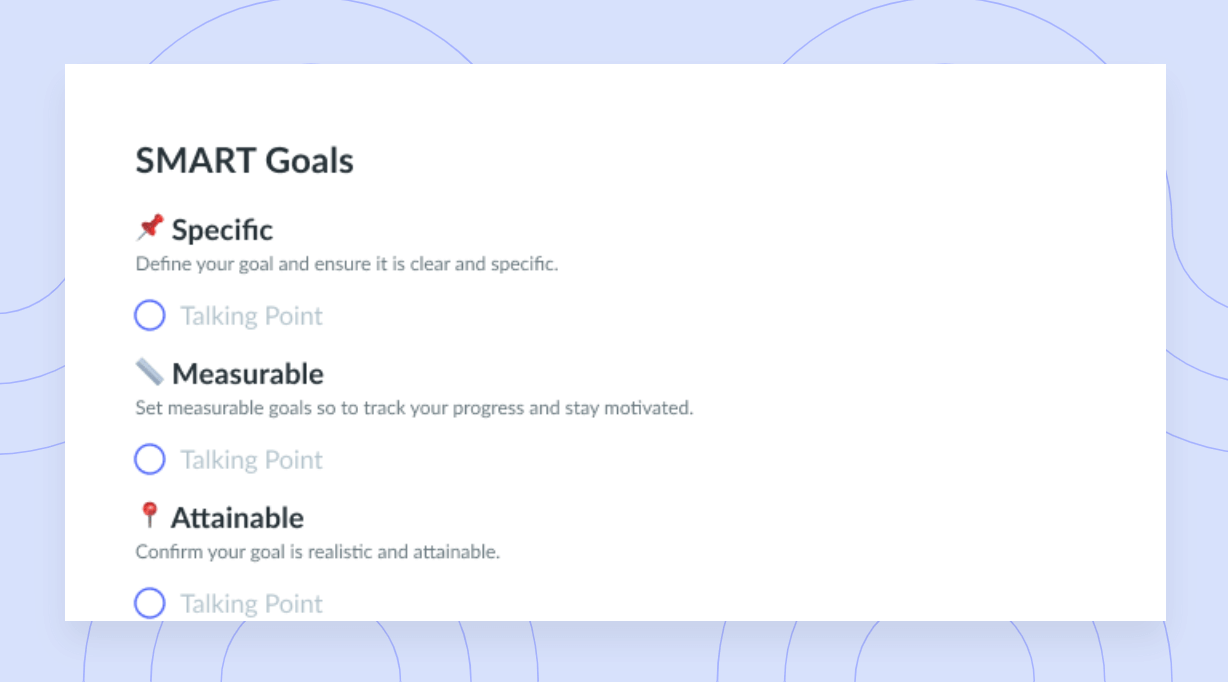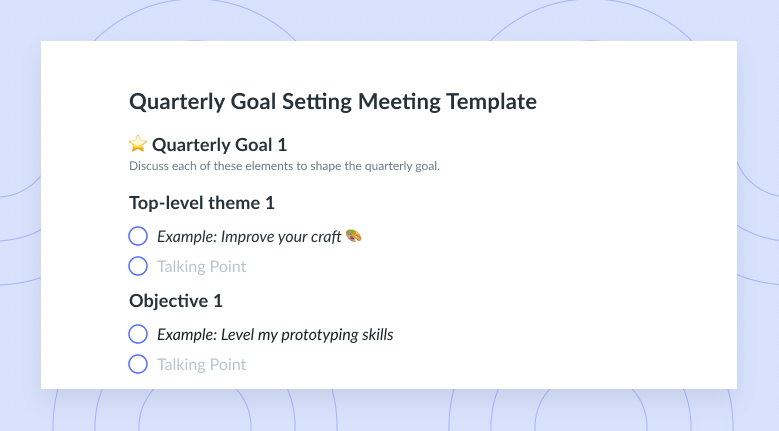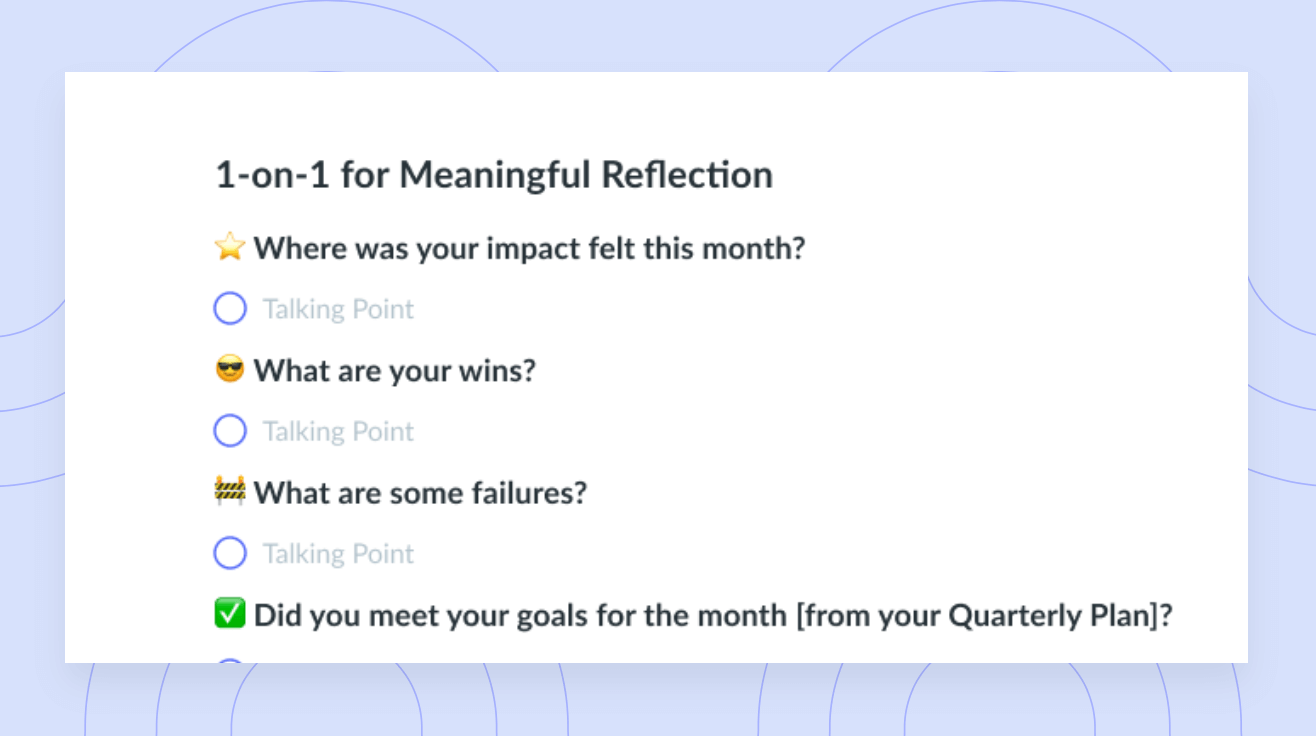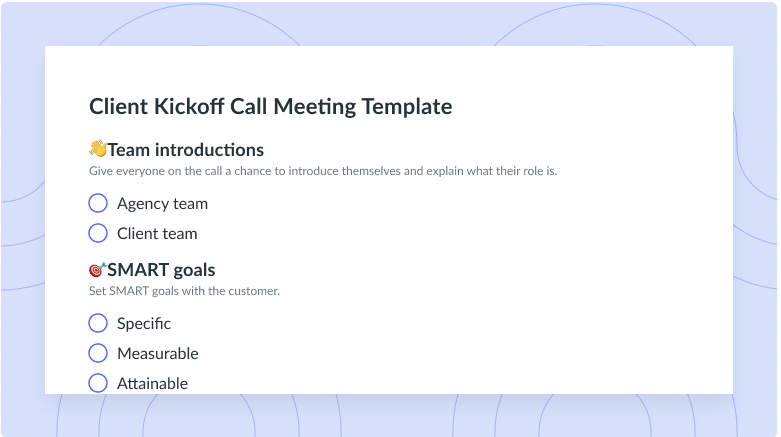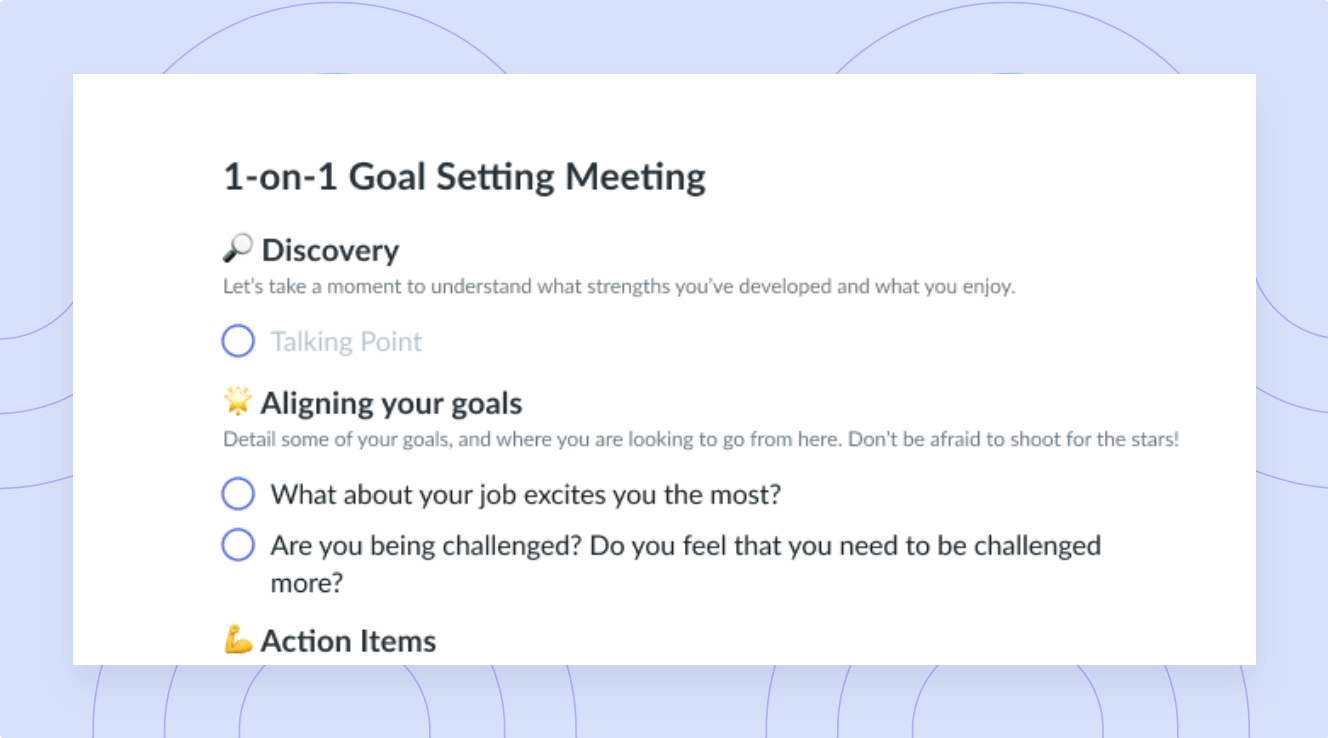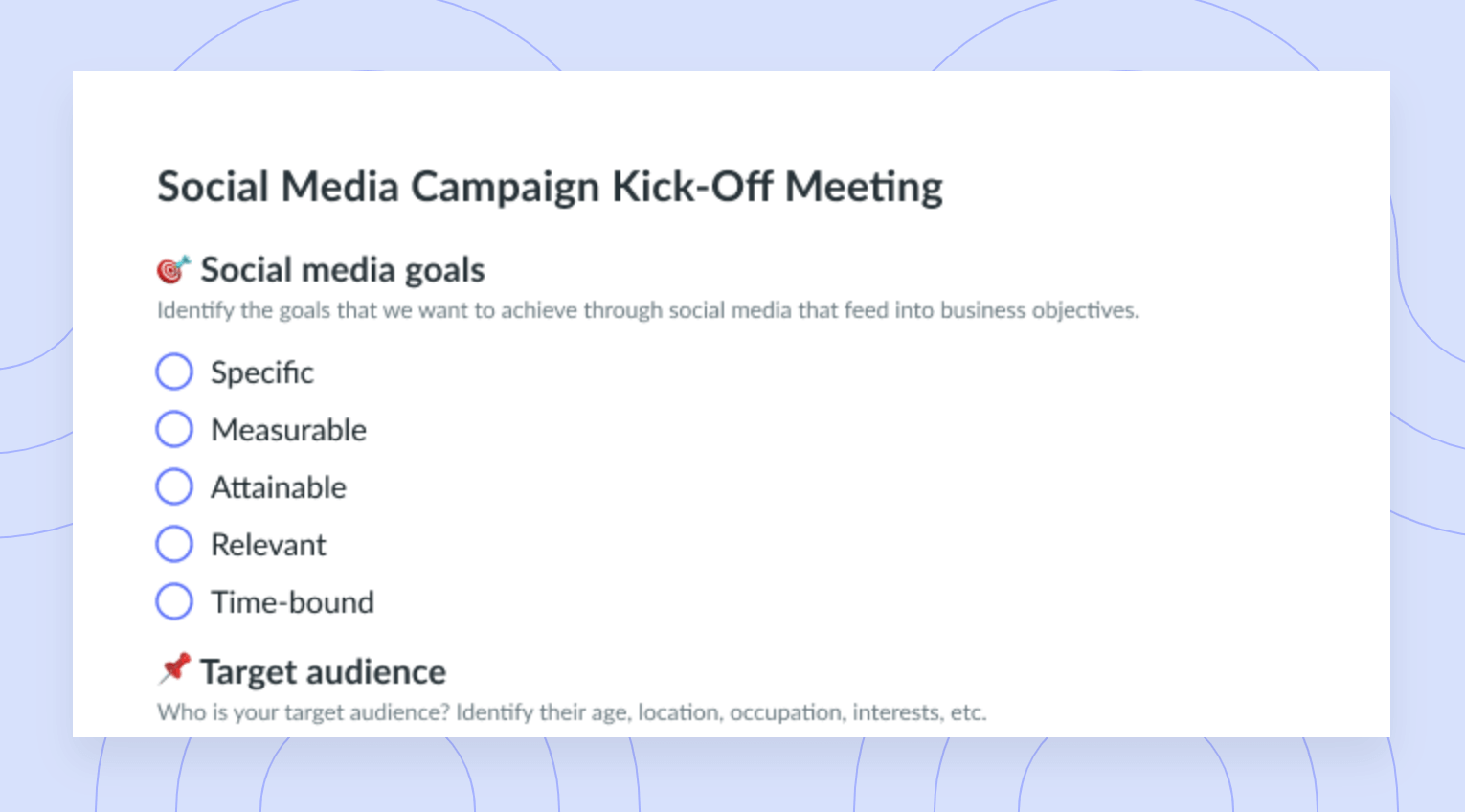15 SMART Leadership Goals Examples
Unlock in-depth SMART leadership goals and examples you can leverage to inspire growth and level up in your career.
Have you been scouring the Internet in search of ways to level up your leadership game? If so, you’ve come to the right place. In this article, we’re diving in headfirst, getting granular with 15 SMART leadership goals and examples. Depending on what your goals are, you can leverage these examples as you kickstart your journey to becoming the best leader that you can be.
- What is a SMART goal?
- How to write SMART goals for leadership
- 15 SMART leadership goals and examples
- How to run a SMART Goal Setting Meeting with Fellow
What is a SMART goal?
A SMART goal is a well-defined objective that follows a specific, measurable, achievable, realistic, and timely framework. This framework is used to create clear and actionable goals that are more likely to be achieved when compared to objectives that are created without this framework. Let’s dive further into each letter of the SMART acronym:
Specific: Each SMART goal you set should be clear and specific, avoiding ambiguity and confusion.
Measurable: A SMART goal must be quantifiable, allowing you to track progress and gauge when it has been completed.
Achievable: Your SMART goal should be realistic and attainable. This means setting parameters that allow you to succeed.
Relevant: Every SMART goal should be aligned with a broader objective. It’s important to ask yourself if the goal you’ve set is part of a bigger plan.
Time-bound: The goal should have a clear timeframe for completion, ensuring you stay on track and motivated.
How to write SMART goals for leadership
As a leader, your SMART goals should directly align with your long-term objectives. For example, if you’re eager to improve your communication skills before stepping into a new role in the next quarter, you’ll want to implement a SMART goal that supports this objective. Additionally, it’s important to use the SMART framework as intended, ensuring each goal is specific, measurable, achievable, relevant, and time bound.

Streamline your SMART leadership goals with Fellow
Discover Fellow’s all-in-one AI meeting management software to effortlessly record, define, and track your goals. Streamline your SMART goals tracking and boost meeting productivity with Fellow!
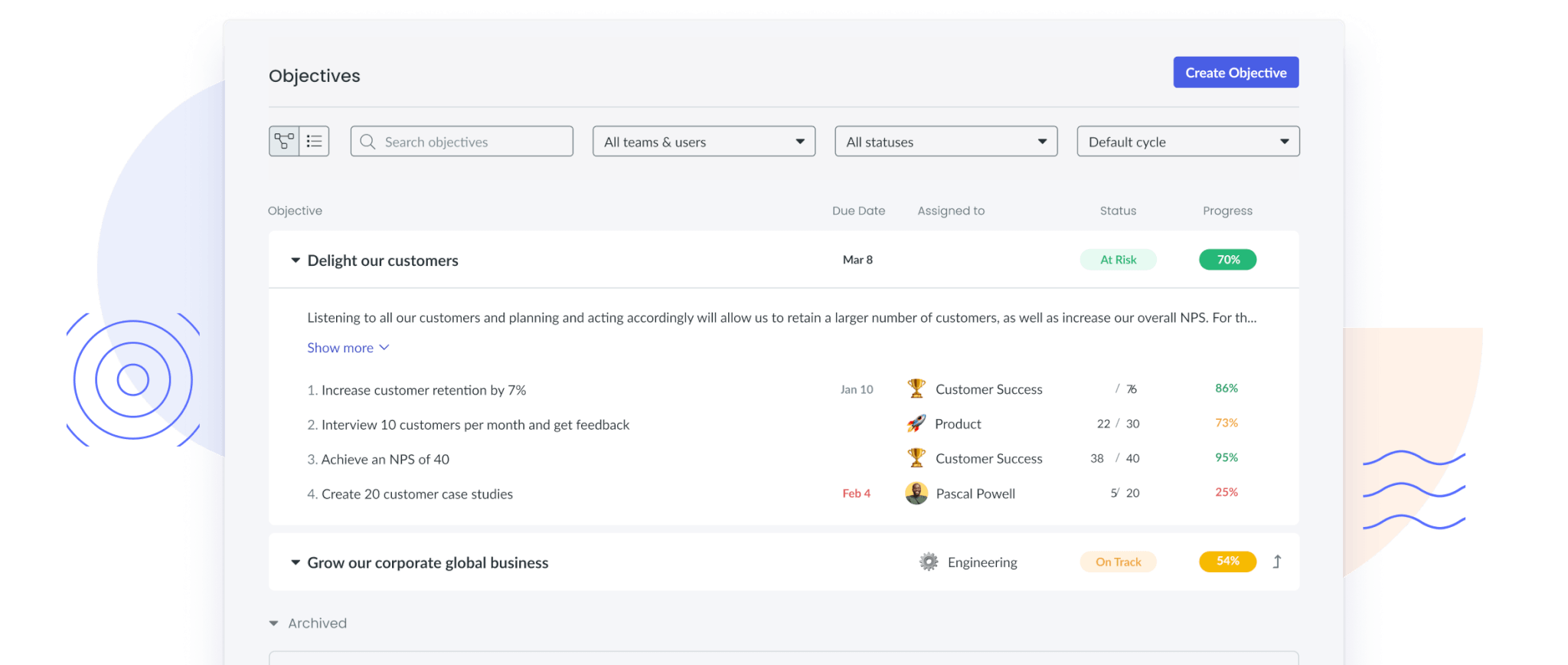
15 SMART leadership goals and examples
- Host regular one-on-one meetings
- Ask for feedback regularly
- Give feedback regularly
- Improve meeting and presentation skills
- Increase employee engagement
- Promote continuous learning
- Enhance time management skills
- Become more adaptable to change
- Become more comfortable with delegation
- Improve resource allocation
- Host office hours
- Set team milestones
- Improve the onboarding process
- Practice active listening
- Reflect on lessons and learnings
1Host regular one-on-one meetings
Creating SMART goals for hosting one-on-one meetings will not only hold you more accountable to your team, but will also enhance communication, engagement, and consistency.
SMART Goal Example:
Specific: Schedule bi-weekly one-on-one meetings with all direct reports to discuss hardships, celebrate wins, and get to know one another.
Measurable: Over the next quarter, ensure all teammates participate in at least one one-on-one meeting per month.
Achievable: Allocate specific time slots in your calendar and ensure these time slots align with everyone on your team. It’s important to consider different time zones and meeting preferences.
Relevant: This initiative will align directly with your desire to enhance communication and strengthen working relationships.
Time bound: Begin scheduling and conducting one-on-one meetings within the next month and track progress over the upcoming quarter.

2Ask for feedback regularly
Asking for feedback is an excellent way to improve your communication skills while ensuring your teammates can voice their thoughts. If you’ve been looking for ways to step up your leadership game, it may be as simple as asking your teammates for feedback using Fellow’s Feedback feature.
SMART Goal Example:
Specific: Using Fellow, request feedback from colleagues at the end of each major project.
Measurable: Aim to receive feedback from at least three sources after each major project over the next quarter.
Achievable: Leverage Fellow to make the process of requesting feedback quick and easy.
Relevant: Seeking feedback will directly impact your ability to level up and become a better leader.
Time bound: Seek feedback as soon as your next project has been completed and maintain this practice for the next quarter.
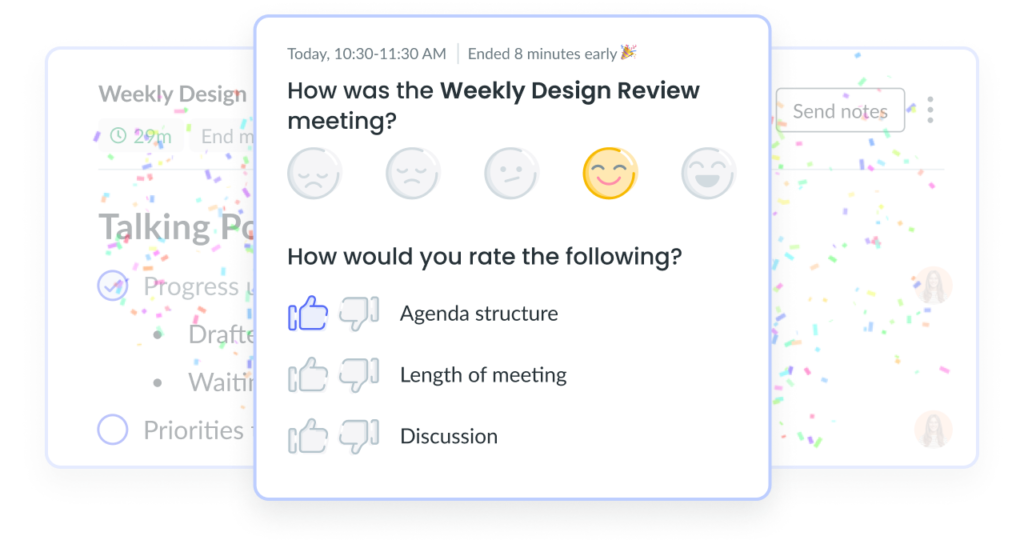
3Give feedback regularly
Giving feedback can be difficult, especially if you don’t have prior experience. Learning to give feedback effectively will help create a culture that embraces feedback as opposed to a culture that resents it.
SMART Goal Example:
Specific: Provide regular feedback during bi-weekly one-on-ones to review feedback, performance, and growth.
Measurable: Over the next quarter, ensure that each teammate has attended at least three feedback sessions.
Achievable: Leverage a feedback tool like Fellow that enables feedback to flow freely from one teammate to the next.
Relevant: This initiative aligns directly with the organization’s desire to develop and nurture talent.
Time bound: Begin scheduling feedback sessions within the next two weeks and gauge effectiveness over the upcoming quarter.
4Improve meeting and presentation skills
As a leader, communication is key. One of the most valuable communication skills a leader can have is being able to effectively lead meetings and presentations—both are crucial to building trust and achieving buy-in. Creating a SMART goal to work towards improving these skills will ensure you’re well on your way to enhancing your ability to communicate effectively with your team.
SMART Goal Example:
Specific: Enroll in an online course catered towards improving meeting and presentation skills.
Measurable: Within four months of completing the course, plan to receive an 85% satisfaction rate from peers and supervisors on the quality of your meetings and presentations.
Achievable: Dedicate a minimum of 45 minutes per week to practicing your learnings.
Relevant: This initiative will serve you directly in your endeavor to become an excellent meeting host and presenter.
Time bound: Plan to enroll in a course by the end of the month and track progress over the next four months.
5Increase employee engagement
As a leader, creating an engaged team should be one of your main priorities. Engaged employees are more motivated, more willing to collaborate, and less likely to leave the organization. Creating a SMART goal that aims to increase employee engagement will ensure employees are motivated, engaged, and more willing to work together towards achieving organizational goals.
SMART Goal Example:
Specific: Implement monthly team-building activities that allow employees to get to know one another beyond work. Plan to circulate surveys after each gathering to gauge whether employees feel engaged, motivated, and part of a team.
Measurable: Within the next quarter, aim to achieve a 20% increase in satisfaction scores on your surveys.
Achievable: Collaborate with HR and team leaders to create engaging activities that employees will love.
Relevant: This initiative will align directly with your desire to create a cohesive work environment with engaged employees.
Time bound: Launch the first team-building event within the next month and plan to track progress over the next year.
6Promote continuous learning
Failing to innovate means falling behind, and you can’t foster growth without continuous learning. Setting SMART goals that pertain to continuous learning will ensure you and your teammates remain competitive in an ever-changing business landscape.
SMART Goal Example:
Specific: Develop an online learning hub where employees can access learning material and training modules.
Measurable: Over the next quarter, plan to increase employee participation in the learning program by 50%
Achievable: Collaborate with HR and team leads to ensure the learning hub is relevant and easily accessible.
Relevant: This initiative will directly align with your desire to foster perpetual growth and continuous learning.
Time bound: Launch your online learning hub within the next quarter and track participation and engagement over the next 6 months.
7Enhance time management skills
As a leader, you’ll constantly be pulled in conflicting directions. Not only will you have your own responsibilities to see to, but you’ll also be responsible for managing a team and communicating between your teammates and management. As a result, you must learn how to effectively manage your time.
SMART Goal Example:
Specific: Set aside one hour every day to plan your time and manage your calendar.
Measurable: Set a timeline and track how your time management skills have improved after integrating these new practices into your everyday routine.
Achievable: Achieve your goal by ensuring you have an hour of time each day to dedicate to enhancing your time management skills.
Relevant: Ensure the new practices you’re integrating into your everyday routine are improving your time management skills.
Time bound: Set a timeline and measure your progress four months after you’ve integrated these new practices into your routine.
8Become more adaptable to change
Today’s business landscape is constantly evolving, which is why it’s important to be adaptable. Leaders who are adaptable to change can navigate it more effectively, ensuring they can lead their team through turbulent times while inspiring confidence and making well-informed decisions.
SMART Goal Example:
Specific: Complete a change management course and apply your learnings in the workplace.
Measurable: After the change management course, set a timeline and track how many occurrences in which you implemented your change management learnings.
Achievable: Invest in an applicable course and follow through on your learnings.
Relevant: Ensure your change management course offers adequate teachings that can be applied in your role as a leader.
Time bound: Set out to achieve your goal in three months after you’ve completed your course.
9Become more comfortable with delegation
Delegation is a crucial skill for leaders as it enables effective time management and allows leaders to empower their team members while driving organizational success.
SMART Goal Example:
Specific: Assign a team member a recurring task for which you’re regularly responsible.
Measurable: Check in with the team member frequently during one-on-ones and discuss progress at the end of each quarter.
Achievable: Ensure each team member who receives a new task has the information and resources necessary to succeed.
Relevant: Delegating tasks to your teammates will ensure you have the capacity to work on high-value tasks that
Time bound: Measure success at the end of each quarter.
10Improve resource allocation
Effective resource allocation ensures that the proper resources are being allocated to the right tasks, projects, and initiatives, ensuring the organization is making the most of its resources while optimizing performance, mitigating risks, and reducing costs.
SMART Goal Example:
Specific: Improve resource allocation in your department by the end of next quarter using a data-driven approach.
Measurable: Achieve a 10% increase in project completion and a 20% reduction in resource-related bottlenecks.
Achievable: Analyze project data and identify trends in resource usage to create a more efficient allocation model by the end of the next quarter.
Relevant: Proper resource allocation will mitigate overallocation and minimize resource conflicts.
Time bound: Measure success at the end of the upcoming quarter.
11Host office hours
Hosting office hours provides leaders with an excellent opportunity to build trust and strengthen working relationships. This time can also be used to help teammates overcome hurdles, problem-solve, and to provide support.
SMART Goal Example:
Specific: Implement a weekly office hours program for all team members to provide dedicated time for hosting one-on-one conversations and providing support.
Measurable: Ensure that each team member has participated in at least three of the office hour sessions by the end of the next quarter.
Achievable: Create a schedule that accommodates various time zones and ensure your time zones are equally accessible to all employees.
Relevant: This initiative will help your teammates as they work towards achieving shared organizational goals.
Time bound: Establish your office hours by the end of the month and track participation over the next quarter.
12Set team milestones
Objective and key result (OKR) setting is often used to paint a clear path forward, eliminating uncertainty and providing leaders with a framework that can be used to move the needle closer to the intended outcome. Did you know that you can stay on top of your team’s goals by clearly recording, defining, and tracking the progress of your OKRs in Fellow’s Objectives tool? With Fellow, it’s as simple as defining a cycle, adding your team’s objectives, specifying your key results, and staying on track by adding an Objectives tab to your team meetings.
SMART Goal Example:
Specific: Leverage Fellow to define measurable OKRs for each project and track progress over the course of the year.
Measurable: By the end of the first quarter, establish at least three quantifiable milestones for each project that your team is working on and build them out in Fellow.
Achievable: Work with your team to identify obtainable milestones that can be realistically reached within the specified timeframe.
Relevant: This initiative will directly support your team members as they work towards achieving shared organizational goals.
Time bound: Complete the establishment of project milestones in Fellow and share them with your team within the next month. Regularly review these milestones on a quarterly basis.
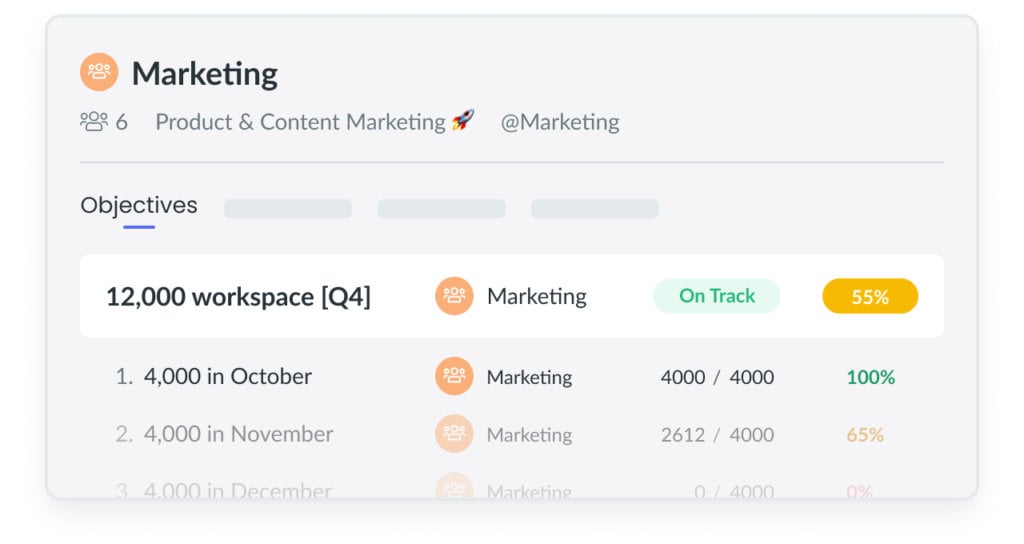
13Improve the onboarding process
Improving the onboarding process is not only an excellent way for leaders to improve new hires’ experience, but it also boosts operational efficiency and employee engagement.
SMART Goal Example:
Specific: Improve the onboarding process to create a smoother transition for new hires.
Measurable: Reduce the average time it takes new hires to integrate into the company within the next 6 months.
Achievable: Collaborate with HR to ensure the new onboarding strategy complies with HR policies and organizational goals.
Relevant: This initiative will reduce time wasted, boost operational efficiency, and improve the employee experience.
Time bound: Implement the updated onboarding strategy within the next six months and track progress over the next year.
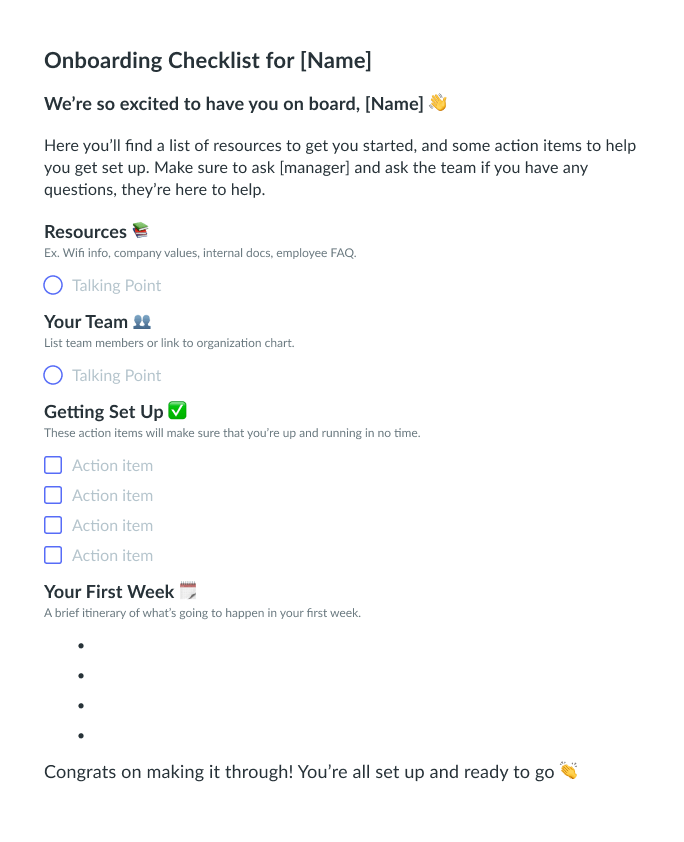
14Practice active listening
As a leader, practicing active listening is an excellent way to build trust and strengthen relationships. Active listening goes beyond simply hearing the words that another person speaks but also seeks to understand the meaning and intent behind them, intending to leave the speaker feeling heard, valued, and understood.
SMART Goal Example:
Specific: Enhance your active listening skills to improve working relationships and communication.
Measurable: Within two months, practice improved active listening skills by summarizing key points and asking clarifying questions at the end of each one-on-one interaction.
Achievable: Enlist the help of an excellent communicator within your organization for expert advice and guidance.
Relevant: This goal supports your desire to build trust and foster stronger working relationships with your teammates.
Time bound: Take the next month to learn from skilled communicators and implement your learnings, making adjustments as needed.
15Reflect on lessons and learnings
As a leader, embracing a growth mindset is a must. Reflecting on lessons and learnings will provide you with the insights necessary to make future improvements while avoiding the same mistakes.
SMART Goal Example:
Specific: Develop a routine of regular reflection to identify lessons and learnings from both successful ventures and failures.
Measurable: Over the course of the next year, prioritize self-reflection by maintaining a journal where you record a lesson learned from each major project or milestone.
Achievable: Start simply by dedicating 15 minutes at the end of each week to record both successors and failures.
Relevant: This goal will align with your commitment to growth and development.
Time bound: Start your reflection journal by the end of the week and maintain consistent entries for the next year.
How to run a SMART Goal Setting Meeting with Fellow
Leadership teams often face challenges when it comes to setting goals, especially after discussing a variety of topics in their respective meetings. Without a proper meeting structure, these goals can easily slip out of focus and be forgotten. With Fellow – the all-in-one AI meeting transcription and management software – your team can rest assured that the leadership SMART goals you set won’t disappear over time.
Here’s how to leverage Fellow to discuss and document your SMART goals:
- Use the SMART Goal-Setting agenda template to run your meeting
- Leverage Fellow’s Objectives and Key Results feature to embed your SMART goals as OKRs in the meeting agenda
- Transcribe the meeting decisions effortlessly with Fellow’s AI Meeting Copilot
With Fellow, you can say goodbye to the chaos of scattered notes and hello to clear and structured SMART goal setting meetings. Setting goals and keeping them top-of-mind during your leadership team meetings has never been easier!
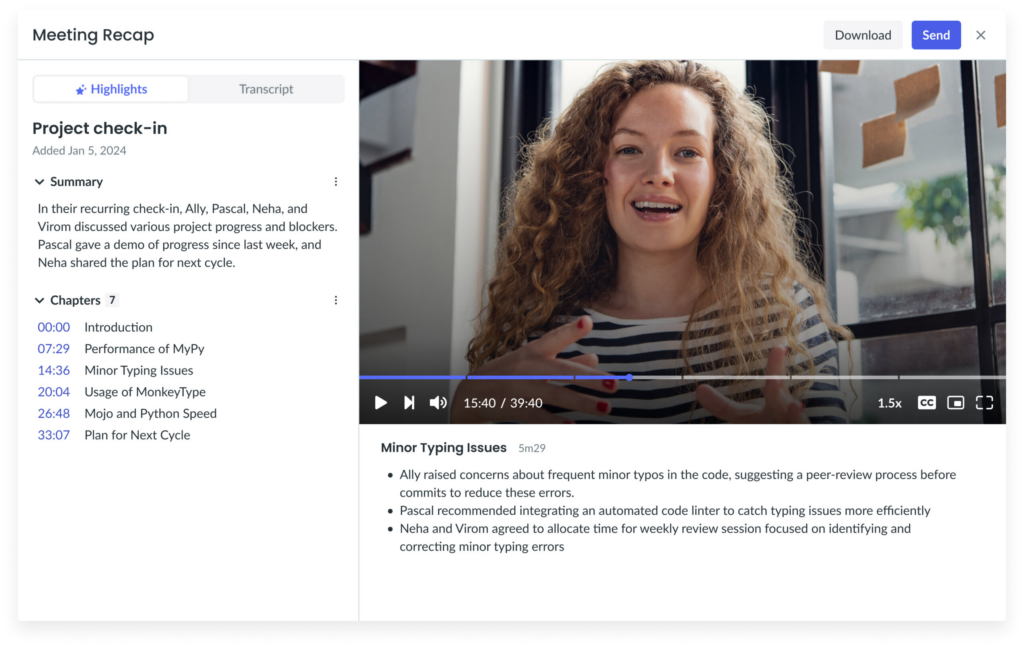



![How to Set Productivity Goals for 2024 [+ Examples]](https://fellow.app/wp-content/uploads/2023/12/productivity-goals-2.jpg)
![How to Achieve Professional Development Goals [+ Examples & Templates]](https://fellow.app/wp-content/uploads/2022/06/Professional-Development-Goal.jpg)




